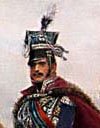
Just for giggles I decided to take some pictures of the newly finished Austrian Infantry (they looked a little short on firepower so my helper suggested the BIGGEST gun to support them).
The force is of regiments of Austrian infantry which were divided into two groups; 'German' and 'Hungarian'. The 'Hungarian' regiments were renowned for their fierce fighting spirit, and their grenadiers were best of them. The 'German' regimnts were the best trained and disciplned part of the infantry. "German sense of duty caused them to rally after lost battle to fight again."
 Can you see them just near the base of the tree?
Can you see them just near the base of the tree?
The 'German regiments' included:
- 11 regiments of Austrians
- 23 regiments of Czechs (Bohemians and Moravians)
- 5-6 regiments of Wallons
- 2 regiments of Croats
- 2 regiments of Tyroleans (46th and 64th, although in 46th the Tyroleans consisted only half)
- 1-2 regiments of Italians
In 1805 10 regiments (9th, 20th, 24th, 30th, 38th, 41st, 44th, 55th, 58th, 63rd) were recruited of Galician Poles and Ukrainians. The Poles had low morale and often deserted to the French or Polish troops fighting for Napoleon. All these units were dressed like 'German' infantry.

The 'Hungarian regiments' included:
- 11-12 regiments of Hungarians.
Perhaps the most important of the reforms carried out by Archduke Charles was the new Dienst-Reglemet. It aimed to humanize discipline and raise troop morale by better treatment. It sharply condemned brutality. The introduction of the code was accompanied by a shortened term or conscription. (Rothenberg - "The Emperor's Last Victory" p 46) The enlistments were 6 years for infantrymen and 10 for cavalrymen.
The Austrian troops were well supplied and equipped. Every soldier carried a fur-covered leather back-pack called Tornister. There was 1 tent for every 5 men, 1 wagon for each company, 4-6 carts and wagons and 30 packhorses with ammunition (on average 36 rounds for every soldier) for every battalion of 6 companies. Officers were also allowed individual packhorses. The senior officers and generals however brought excessive baggage, numerous carts and horses. It slowed down movements of the army. In 1809 regiment of infantry had 26 packhorses, while Grenzer regiment only 7. The Jäger battalion had 12 and cavalry regiment none. The supplies for infantry regiment were carried on 13 wagons (4 horses each) and 26 pack animals.
Although as an army the Austrians lost more battles than won, the individual line regiments were reliable and some fought with tenacity and bravery.

The term militia is commonly used today to refer to a military force composed of ordinary citizens to provide defense, emergency law enforcement, or paramilitary service, in times of emergency without being paid a regular salary or committed to a fixed term of service. Legal and historical meanings of militia include:
Defense activity or service, to protect a community, its territory, property, and laws.
The entire able-bodied male (women are usually called to work in munitions factories) population of a community, town, county, or state, available to be called to arms.
A subset of these who may be legally penalized for failing to respond to a call-up.
A subset of these who actually respond to a call-up, regardless of legal obligation.
A private, non-government force, not necessarily directly supported or sanctioned by its government.
An official reserve army, composed of citizen soldiers. Called by various names in different countries such as; the Army Reserve, National Guard, or State Defense Forces.
The national police forces in several former communist states such as the Soviet Union and the Warsaw Pact countries, but also in the non-aligned SFR Yugoslavia. The term was inherited in Russia, and other former CIS countries. See: Militia (Police).
In France the term "Milice" has become tainted due to its use by notorious collaborators with Nazi Germany.
While my top hat wearing militamen do not look exactly like the great Grenzers of Austrian fame...they may well get the designation in battles to come...

Border Troops - The Grenzers.
The Grenzers came from military frontier between Austria and Turkey settled by Christian refugees. During peacetime the Grenzers spent 7 months of every year guarding the frontier. They were raised as militia but were considered by army officials as something between light and line infantry. The Grenzers were given training in marksmanship and skirmishing and basics of linear tactics. When attempts were made to train the Grenzer as line infantry they turned out to be not as good in this role as the regular regiments.
There were 17-18 Grenzer regiments each of two or three battalions. During wartime one battalion of every regiment was left to guard the border with Turkey. The other battalion or two joined the regular army and were part of advance guards.
The Grenzers lacked weapons, uniforms and discipline. But despite the shortcomings the Grenzer battalions performed well in combat (for example at Malgaboreth, Eggmuhl, Wagram and others). According to many experts, including Christoipher Duffy, they were "the most enthusiastic troops" of the Austrian army. When many Austrian regulars fled at Austerlitz the Grenzers fought hard and lost 66 % !
During retreat after Marengo (1800) when all order broke, two battalions of Grenzers (Warasdin-Kreuz and Ottocac) fended off all attacks and allowed the grenadier battalions to march to the Bormida. Together with the grenadiers they fought one of the last rearguard actions at Marengo.

The French had good opinion about the Grenzers and considered them as the only ones looking warlike in the entire Austrian army. Napoleon had no hesitation in using these wild men. (After the defeat in 1809 Austria ceded some territories and the 1st, 2nd, 3rd, 4th, 10th and 11th Grenzer Regiment went into French service. They served for Napoleon

So much for the history lessons, enjoy the eye candy and tell me what you think.
I feel a new inspiration coming on...



















































.jpg)






















